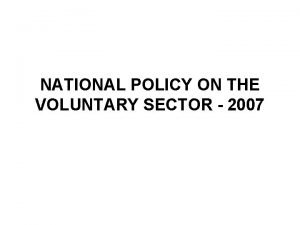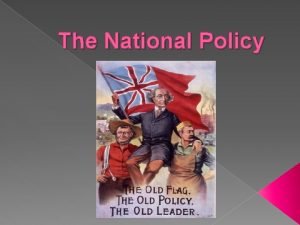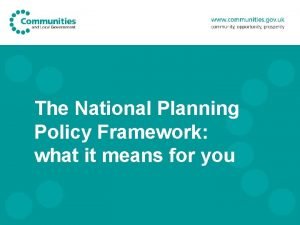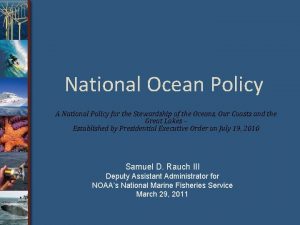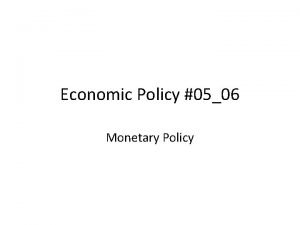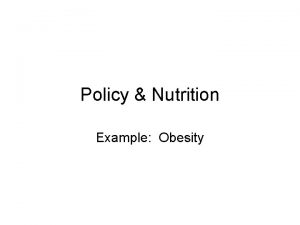The National Policy What was the National Policy

















- Slides: 17

The National Policy

What was the National Policy? A policy to strengthen Canada as a country To unite a country “sea to sea”!!!! Canada’s flag – 1868 - 1921

Background. . . Between 1874 and 1878, Canada was enduring a depression. Many people had lost their jobs and were unemployed

What did Canadians do? Many people left Canada, and headed to the United States Fewer immigrants were willing to settle in Canada at this time

Who took action? John A. Macdonald He wanted to restore the pride of Canadians With an emotional “National Policy” he could also win the next election

What did Macdonald do? It was passed in 1879 to the delight of many Canadians (There were others who HATED it – particularly in the west. )

The National Policy had 3 parts: 1. Build a railway from coast to coast 2. Promote immigration so the West could be settled 3. Place tariffs on goods being imported into Canada to protect Canadian manufacturing

Part One. . . The Canadian Pacific Railway would be built

Part Two. . . The government would encourage immigration to Canada.

Part Three. . . › It included a high tariff to keep out foreign goods (cheaper American goods) › This would provide a boost to industry in eastern Canada › It would promote east-west trade (instead of north-south trade with the U. S. )

The Details. . . The CPR had to be built Canada had to attract immigrants to settle the West The tariff had to be implemented

Problems … But … the railway’s route went right through Aboriginal lands Land needed to be provided for the immigrants who would settle the Canadian West This would result in violence and rebellion

Treaties resulted The government negotiated with Aboriginal peoples to acquire their land Treaties were signed. Reserves were established Assimilation of Aboriginal peoples was the goal

Residential Schools: Purposes Established by Canadian government to help Aboriginal peoples assimilate into Canadian society. Christianity and English were viewed as a route to success. Over time, it was hoped that Aboriginal culture would disappear.

Residential Schools “Aggressive assimilation" was to be taught at church-run, governmentfunded industrial schools, later called residential schools. The government felt children were easier to mould than adults, and the concept of a boarding school was the best way to prepare them for life in mainstream society.

Results of the National Policy Tariffs were implemented (though later removed. ) The CPR was built Immigration to the Canadian West was HUGE! Treaties were negotiated Residential schools were established and their legacy lives on today

The end
 National medicines policy
National medicines policy Existanxe
Existanxe Dr. kanupriya chaturvedi
Dr. kanupriya chaturvedi Conclusion of national policy on education 1986
Conclusion of national policy on education 1986 National policy on the voluntary sector 2007
National policy on the voluntary sector 2007 The national policy
The national policy Objective of zoo
Objective of zoo A national policy of avoiding involvement in world affairs
A national policy of avoiding involvement in world affairs Education policy 1998 to 2010
Education policy 1998 to 2010 What is national planning policy framework
What is national planning policy framework National policy and legislation related to child health
National policy and legislation related to child health Dr. kanupriya chaturvedi
Dr. kanupriya chaturvedi Chụp phim tư thế worms-breton
Chụp phim tư thế worms-breton ưu thế lai là gì
ưu thế lai là gì Thẻ vin
Thẻ vin Thơ thất ngôn tứ tuyệt đường luật
Thơ thất ngôn tứ tuyệt đường luật Cái miệng xinh xinh thế chỉ nói điều hay thôi
Cái miệng xinh xinh thế chỉ nói điều hay thôi Các châu lục và đại dương trên thế giới
Các châu lục và đại dương trên thế giới




